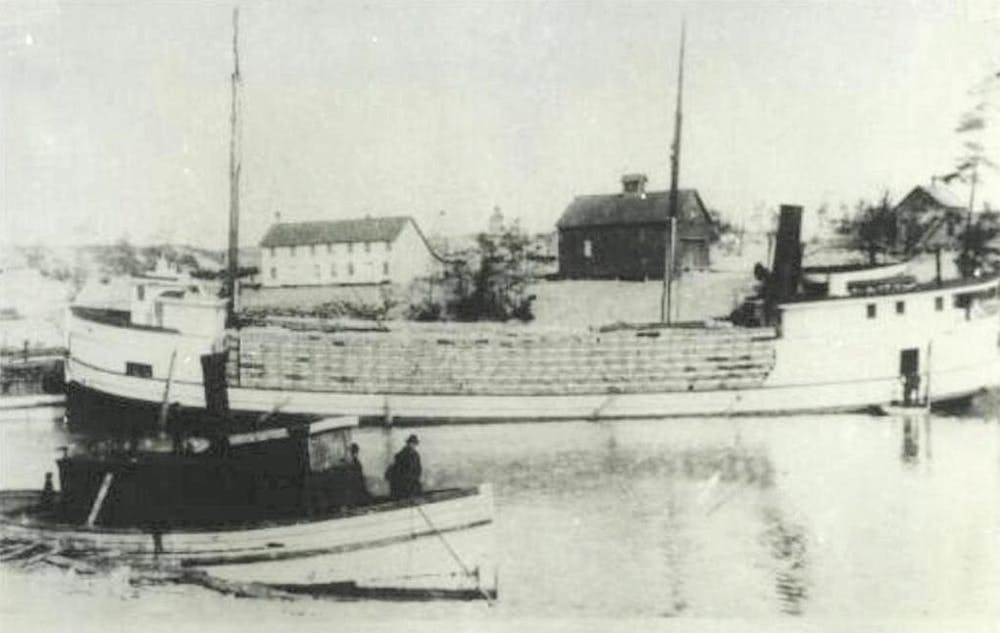The A. D. Hayward was built in Manitowoc, Wisconsin, by Burger & Burger in 1887 for the White Lake Transportation Co., a partnership composed of M. B. Covell, C. E. Covell, and P. D. Campbell. It was named for Ambrose D. Hayward, who had a long business relationship with the Covell brothers and an interest in one of their mills. The Hayward was a replacement for the R. C. Brittain.
The vessel arrived on WhIte Lake for the first time July 19, 1887 and moored at Covell’s wharf. During the afternoon and evening, swarms of people visited the boat and all were highly pleased with her splendid appointments.
The ship was 145 feet overall in length and 29 feet in width. The wheelhouse was roomy and supplied all the modern conveniences of navigation at the time. There was a spacious cook room and pantry. There were 12 staterooms fitted up with the utmost comfort and some of them furnished ensuite for family use. There was ample accommodation for 40 passengers in the cabin.
The officers of the boat were: Captain Peter D. Campbell; first mate Smith Sanders; second mate E. L. Knudsen; first engineer Emory Christian; and steward I. Berd.
The propeller was expected to easily carry 300,000 feet of lumber and, notwithstanding its increased size over the Brittain, could be about an hour faster on the run between Whitehall and Chicago.
On Aug. 4, 1887, as the Hayward was moored at the lumberyard of R. L. Henry about four miles up the Chicago River, she met with a terrible disaster. It seems one of the firemen, Herman Fisher, had been giving the boilers a coat of varnish and was about to ascend a ladder leading from the boiler room when his foot slipped and the pail of varnish and lantern he was carrying fell to the floor. In an instant, flames spread everywhere. A heavy plate covered the hatch, through which Fisher must reach the deck, and he could not remove it. With the fire all about him, Fisher reached his hands up through an opening and called “fire” at the top of his voice. Assistant engineer Dick Hall, who was lying in his bunk near the hatch, heard the alarm and, jumping up, saw Fisher’s hands. Hall got the man out on the deck where a patrol was summoned and Fisher was taken to a hospital for treatment of his wounds.
Engineer Christian started the boat’s pony pump, but the flames spread with such lightning speed that nothing could be done by the crew. A fire tug and steam engine were promptly on hand but despite their efforts, the entire cabin was soon a mass of seething flames. The stern lines were let go and the boat swung out into the middle of the river, where steady streams of water finally got a handle on the fire. It was not stopped, however, until the afterdeck, the elegantly furnished passenger cabins with all the contents, the deck with the lifeboats and other materials had been burned. About half of the deck load of lumber had been removed and the end of what remained next to the fire was badly charred.
The Hayward was insured for $20,000, and the damage was estimated at $7,000. It is thought the cabin would not be rebuilt that season, but she was repaired for the lumber trade and a new cabin would be put on next winter. The Hayward had made but a few trips since she was finished, but this was the second fire she experienced. The first one occurred when she was lying at Grand Haven and was caused by the melting of a lantern in the engine room.
As for the condition of the injured fireman, Herman Fisher, reports indicated he had rapidly improved and would soon be out of the hospital.
In July 1888 the White Lake Transportation Co. closed a deal where the propeller A. D. Hayward was sold to S. R. Howell, a lumberman of Chicago. The consideration paid was $30,000. During the winter, the company built the M. B. Covell for the White Lake traffic. The Hayward’s capacity was big, having carried as much as 410,000 feet of lumber in one cargo. The company found it inconvenient to handle her that season, as the trips had been long ones and the low rates made the business barely self-sustaining. Her entire crew, except Capt. Sanders, was retained by the new owner and was thought to be a profitable investment.












